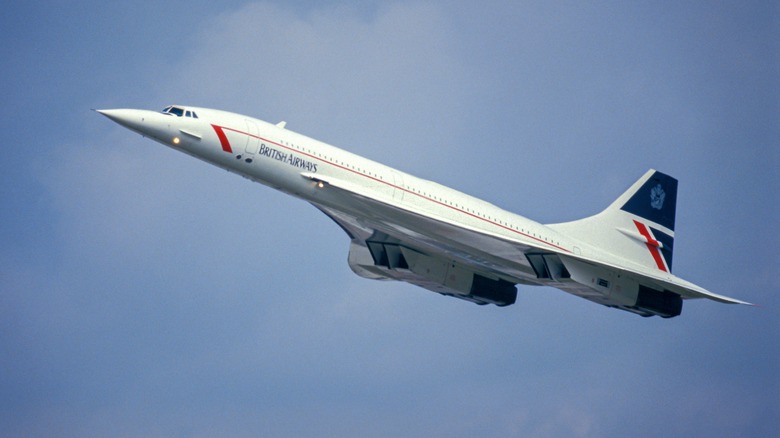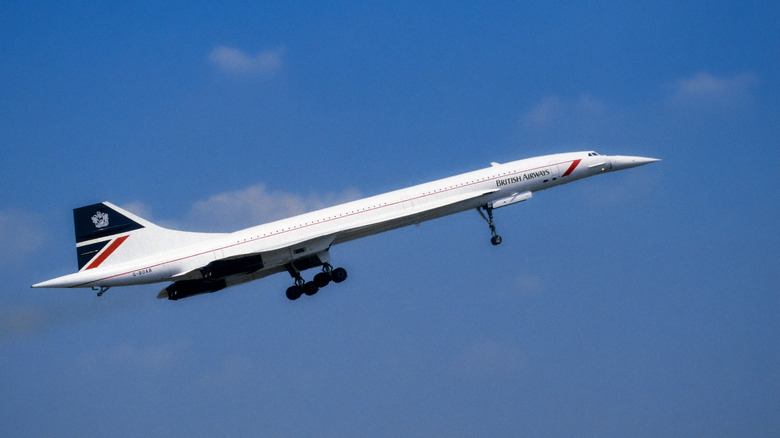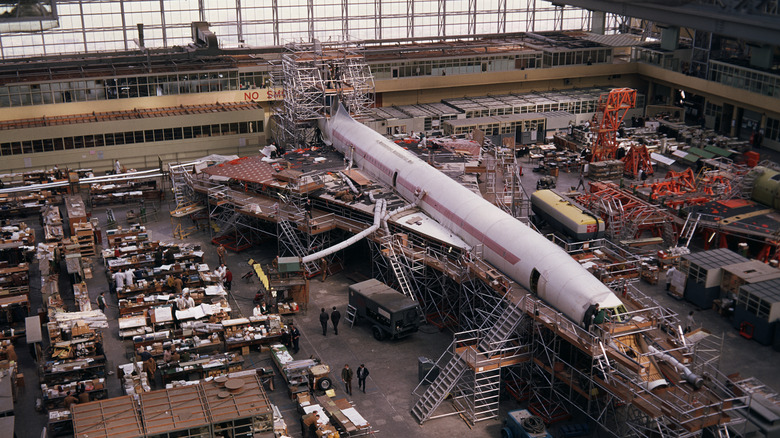Unveiling The Secrets Behind The Concorde's Record-Breaking Flights
When a plane like the Concorde Jet is ahead of its time and doesn't ultimately last, it's more than simply a defunct project, it's a failed promise of the future, of what could have been. There was once a supersonic passenger jet that could travel faster than the speed of sound and cut half the flight time off routes, but today we still only have regular, non-supersonic flights. It's the same feeling you get when stepping off one of those moving walkways at the airport.
The Concorde was essentially a record-breaking machine. It could achieve speeds of 1,354 mph, otherwise known as Mach 2.04, which is more than twice the speed of sound. In 1996, that's what enabled it to traverse from New York City to London in a paltry two hours and 53 minutes, a record that Guinness labeled the "fastest flight across the Atlantic in a commercial aircraft." This isn't to suggest that every flight it offered passengers would regularly achieve such record-breaking speeds, but every aspect of its design was streamlined with an eye toward really fast flights.
Where that innovative speed came from
A rare collaboration between the French and British aviation industries, the idea behind the Concorde was to significantly reduce long-haul flights in key routes around the world. It certainly did. It was powered by four afterburner-equipped Olympus 593 Mk610 turbojet engines, an engine technology often reserved for military jets and found on Avro Vulcan strategic bombers. Like those bombers, the Concorde had the ability to travel at altitudes upwards of 60,000 ft, meaning it encountered thinner air and less drag than lower, traditional commercial flights.
The Concorde managed to even look fast while parked, and there was a reason for that. Every part of the aircraft –- from the adjustable, downward-turned nose to the stretched-out body to the curved wings – was streamlined to reduce drag and increase flying speed. Those delta-wings (once again similar to the Avro Vulcan) were set at a 55-degree angle with the fuselage, reducing drag along a body designed to absorb the impact of shockwaves while traveling at supersonic speeds.
When it comes to the record-breaking transatlantic flight, the time achieved was more than due to the aforementioned design specs, as Simple Flying notes. It was planned that way by everyone involved, including Captain Leslie Scott, First Officer Tim Orchard, and Engineering Officer Rick Eades. They apparently chose February for its ideal upper air temperature and wind velocity, and achieved Mach 2 quickly and for as long as possible during the flight. Additionally, while the approaching runway at Heathrow usually had flights arriving from the east, the Concorde was coming from the west and convinced air traffic controllers to let them land that way to preserve the record-breaking flight time. It's safe to say that such considerations aren't usually made for other flights that don't break records.
Why it came to an end
Building, operating, and maintaining such an advanced aircraft came with exceedingly high costs, which seemingly hamstrung the program from the start. Work on the aircraft exceeded $2 billion, over four times the initial estimate, and the aircraft consumed around 6,770 gallons of fuel per hour of flight, about double the amount of the giant Airbus A380, according to How Stuff Works. These high production and maintenance costs came against inevitable high ticket costs that were out of reach for the average passenger, often between $12,000 to $14,000 for a roundtrip ticket.
Then in July 2000, an Air France Concorde departed Paris's DeGaulle airport for New York, when one of the engines caught fire and caused the aircraft to crash in France, killing all 109 passengers aboard, as well as four people on the ground. After a year-long grounding by the FAA, the Concorde's last commercial flight came in 2003, with the 100 celebrity-laden passengers spending upwards of $60,000 for a roundtrip ticket from JFK to Heathrow.
While supersonic commercial flights remain highly costly and impractical for the immediate future, the Concorde's innovation continues to make waves in the airline industry, in the hopes of mainstreaming commercial supersonic speeds that are both convenient and safe for passengers seeking to arrive a little sooner. American company Boom Supersonic hopes for its Overture SST to reach this with the 75% less cost, and last year CNN reported that European company Destinus was targeting hypersonic flights between Dubai and Memphis. Where this all goes remains to be seen, yet perhaps one day it'll take us to a time when we're no longer romanticizing the Concorde because we have something better. But that'll probably take a while.


